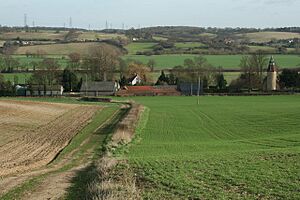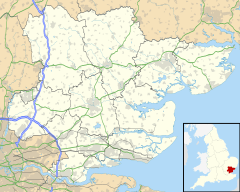Lamarsh facts for kids
Quick facts for kids Lamarsh |
|
|---|---|
 Lamarsh hall and church |
|
| Population | 187 (2011 Census) |
| Civil parish |
|
| Shire county | |
| Region | |
| Country | England |
| Sovereign state | United Kingdom |
| Post town | Bures |
| Postcode district | CO8 |
| Dialling code | 01787 |
| Police | Essex |
| Fire | Essex |
| Ambulance | East of England |
| EU Parliament | East of England |
Lamarsh is a small village and parish in Essex, England. It's part of the Braintree District. The village is close to Bures and Alphamstone. The River Stour flows to the west of Lamarsh.
Lamarsh has a pub, a village hall, and a church called Holy Innocents. The name Lamarsh means 'loamy marsh'. It comes from old English words for 'loam' (a type of soil) and 'marsh' (wetland).
In the 1870s, people described Lamarsh like this:
- "LAMARSH, a parish, with a village, in the district of Sudbury and county of Essex; adjacent to the river Stour at the boundary with Suffolk, 2½ miles NW of Bures r. station, and 4 SSE of Sudbury."
Contents
Exploring the Parish of Lamarsh
The parish of Lamarsh covers about 934 acres. It used to be bigger, including 200 acres of farms until 1884. The main buildings in the parish are Lamarsh Hall and Daws Hall. There are 22 historic buildings in the parish that are 'listed', meaning they are protected.
Lamarsh has 86 homes, and none of them are shared. The village doesn't have any shops. But it does have a public house, which is a type of pub. It's called the "Lamarsh Lion".
Understanding Lamarsh's Population Changes
The population of Lamarsh was 285 people in 1801. It grew to its highest point of 409 people in 1851. After that, the population dropped a lot by 1891, down to 196 people. It never went above 202 again.
This big drop might be because the size of the parish got much smaller. It went from 1,268 acres in 1881 to 940 acres in 1891. This change would have meant fewer people were counted in the parish.
Who Lives in Lamarsh Today?
In 2011, the total population of Lamarsh was 187 people. There were 96 males and 91 females living there. Most people in the area are White British. About 95.2% (178 people) belong to this group. The next largest group is White and Asian, with only 3 people (1.6%). This shows that Lamarsh doesn't have much ethnic diversity.
Because most residents are White British, Christianity is the main religion. About 66.3% (124 people) said they were Christian. Also, 37 people (19.8%) said they had no religion.
Most people in Lamarsh were born in England. The 2011 census showed that 92% (172 people) were English. The rest of the population were born in other countries. These include Wales, Scotland, Ireland, and other countries in the European Union.
Jobs and Work in Lamarsh's History
We have detailed information about jobs in Lamarsh from 1881. At that time, there were 69 males and 77 females in the village. Most men worked in farming. About 54 out of 69 men had jobs in agriculture. Women mostly worked in homes or offices. However, 45 women were listed with 'unknown occupation'. This might mean they were housewives.
In 1881, there were 141 males and 133 females in the village. This means that more than half of the men and women were either too young or too old to work. Or, their jobs were not recorded.
Modern Jobs in Lamarsh
Today, 82 of Lamarsh's 187 residents have jobs. This includes 42 males and 39 females. A large number of employed people (25, or 30.5%) work in 'Professional Occupations'. This is a big change from 1881, when only 3 professionals lived in Lamarsh.
The second most common job type is 'Associated Professional and Technical Occupation'. About 17 people (20.7%) work in this field. In 1881, farming was the biggest job, with 55 workers. Now, only 2 people in Lamarsh work in agriculture. This shows that Lamarsh has changed from a farming village to one with more professional jobs.
Social Life in the Past
Census information from 1831 also tells us about Lamarsh's social structure. Jobs were grouped by social status. The data showed that 73 people were 'labourers and servants'. There were 12 'middling sorts' and 7 'employers and professionals'. This means that most people in the parish were working-class. They worked for the richer employers and professionals.
The Historic Holy Innocents Church
The Holy Innocents Church is thought to have been built around 1140. It has a Grade 1 listing from English Heritage. This means it's a very important building for its architecture. Its dedication to "Holy Innocents" is rare. It's one of only five churches in England with this name.
The church stands in the middle of the parish. Its walls are made of flint-rubble and covered in concrete. The roof is tiled. A large 'round tower' was built on the west side of the church. In the 19th century, an Essex Spire was added to the top. This spire was repaired in 1948 and again in 1974. Lamarsh Hall is about 100 yards north of the church and has a moat around it.
Famous People from Lamarsh
- Sefton Delmer was a journalist. He worked for the British government during World War II. He led a secret radio campaign against Hitler from England.
- Robert Bamford was born in Lamarsh in 1883. He was one of the two people who started the famous car company Aston Martin.
Images for kids





